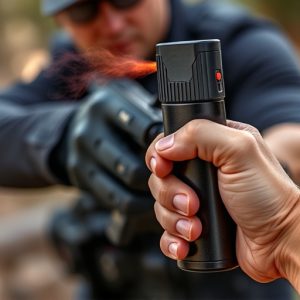Pepper Spray Holster Safety Tips: Design, Storage, Deployment & Legal Protocols
Pepper spray holsters offer various designs for law enforcement, but safety is paramount. Officers m…….
Pepper spray holsters offer various designs for law enforcement, but safety is paramount. Officers must undergo regular training on release mechanisms, maintenance, and inspection to ensure reliable deployment during high-pressure situations. Following Pepper Spray Holster Safety Tips, including secure storage and strict handling protocols, enhances operational effectiveness while minimizing risks. Effective deployment techniques, such as close-range activation, facial aiming, and de-escalation methods, are taught alongside legal considerations specific to jurisdiction and force usage regulations. Regular training sessions, combined with proper equipment maintenance, foster public trust in responsible use of force.
“In the realm of law enforcement, pepper spray is a crucial non-lethal weapon, but its effective use hinges on understanding and practicing safe procedures. This article explores the essential aspects of pepper spray equipment, focusing on holster design, storage, deployment, and legal protocols. From ensuring Pepper Spray Holster Safety Tips to mastering effective training techniques, learn how to optimize your gear for real-world applications. Discover best practices that can enhance officer safety and comply with use policies.”
- Understanding Pepper Spray Holster Design and Functionality
- Ensuring Safe Storage and Handling Procedures
- Effective Deployment Techniques and Training
- Legal Considerations and Use Protocols for Law Enforcement Officers
Understanding Pepper Spray Holster Design and Functionality
Pepper spray holsters are designed with both practicality and safety in mind. They come in various types, from belt-mounted options to pocket models, each offering unique features for different user preferences and needs. Understanding how these holsters function is crucial for law enforcement officers to ensure effective deployment during high-pressure situations. The typical pepper spray holster consists of a casing that securely holds the spray canister, often featuring a trigger mechanism designed for quick access.
When it comes to pepper spray holster safety tips, officers should familiarize themselves with the holster’s release system, ensuring they can deploy the spray swiftly yet accurately. Proper training on holster maintenance and inspection is vital to prevent malfunctions. Regular testing of the trigger and overall functionality helps maintain reliability, especially in stressful conditions. Additionally, officers must learn safe handling practices to avoid accidental discharge, which could have severe consequences, both for the officer and bystanders.
Ensuring Safe Storage and Handling Procedures
Ensuring safe storage and handling of pepper spray equipment is paramount for law enforcement agencies to maintain effectiveness and mitigate risks. According to Pepper Spray Holster Safety Tips, proper storage involves keeping the sprays in secure, designated areas with limited access, ideally locked cabinets or compartments. This prevents unauthorized use or misuse, which could lead to dangerous situations.
Handling procedures should be strictly followed by all officers. This includes wearing protective gear during deployment, ensuring good ventilation, and storing used canisters separately from new ones. Awareness of proper usage techniques also reduces the risk of injury, both for the officer and the subject, emphasizing the importance of regular training sessions in addition to clear storage protocols.
Effective Deployment Techniques and Training
Effective deployment techniques are crucial for law enforcement officers using pepper spray as a less-lethal tool. According to research, proper training and adherence to Pepper Spray Holster Safety Tips significantly enhance its effectiveness while minimizing risks. Officers should be taught to activate the spray at close range, aiming for the face and eyes, to ensure maximum impact without endangering bystanders. Regular simulations under controlled conditions help officers hone their skills in handling resistance and managing subjects safely.
Training also emphasizes the importance of maintaining a safe distance, using the spray only as a last resort, and understanding the de-escalation process. These practices not only maximize the tool’s efficacy but also foster public trust by demonstrating responsible use of force. Pepper spray equipment should be thoroughly inspected and maintained to ensure optimal functioning, further complementing rigorous training protocols.
Legal Considerations and Use Protocols for Law Enforcement Officers
Law enforcement officers must adhere to strict protocols and legal considerations when carrying and using pepper spray. This includes understanding their jurisdiction’s specific laws regarding the use of force, as well as the state or local regulations that govern the deployment of pepper spray. Officers are required to receive comprehensive training on the equipment, including safety tips for pepper spray holster usage. Proper holster placement ensures both accessibility during an encounter and minimal risk of accidental discharge, which could harm bystanders or colleagues.
Use protocols dictate when pepper spray can be employed, focusing on de-escalation methods first. Officers must assess the threat level and determine if less lethal force is appropriate before resorting to pepper spray. Training emphasizes responsible use, teaching officers to target specific areas of the body to minimize harm and enable suspects to recover quickly. Additionally, departments establish guidelines for maintenance and inspection of pepper spray equipment, including regular holster checks to ensure functionality and proper condition.
In conclusion, a well-designed pepper spray holster, combined with proper storage, handling, and deployment techniques, is an invaluable asset for law enforcement officers. Following safe practices and understanding legal protocols ensures that this powerful tool can be effectively utilized while minimizing risks. By implementing these Pepper Spray Holster Safety Tips, LEOs can enhance their capability to maintain public safety and comply with established use guidelines.


